1995 Nissan Skyline R33 GT-R Still Feels Special
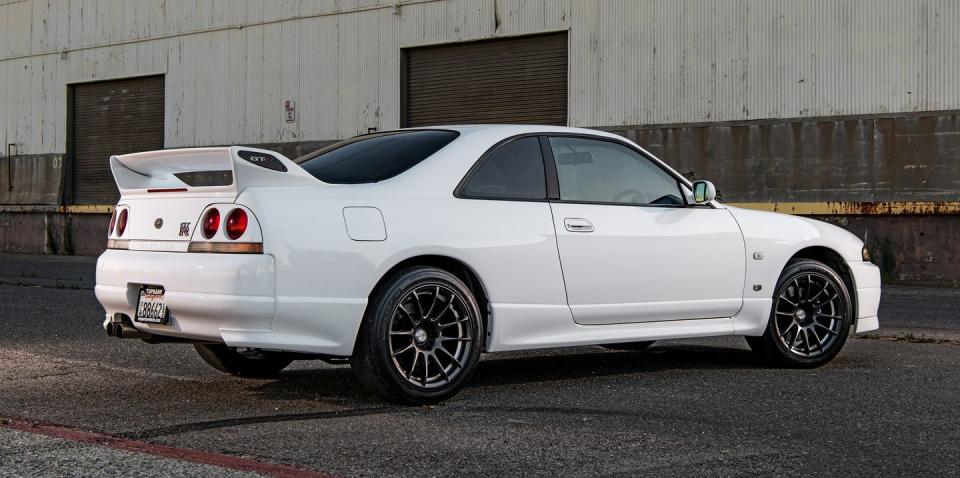
Nissan sold just 13 of its GT-R sports cars in the United States this past April. Toprank International Vehicle Importers wasn't far behind. It sells about 10 GT-Rs a month, old ones: R32s, R33s, and the occasional R34.
Toprank's director, Sean Morris, has been involved in the import of Nissan's turbocharged all-wheel-drive coupes for more than 20 years. Today Toprank is one of the country's leading importers of vintage GT-Rs and other Japanese performance cars from the 1980s and 1990s. We've been promised a drive in a 1995 R33 GT-R, and we arrive to find it parked out front alongside one of Morris's personal R32s that has been tuned to produce more than 500 horsepower.
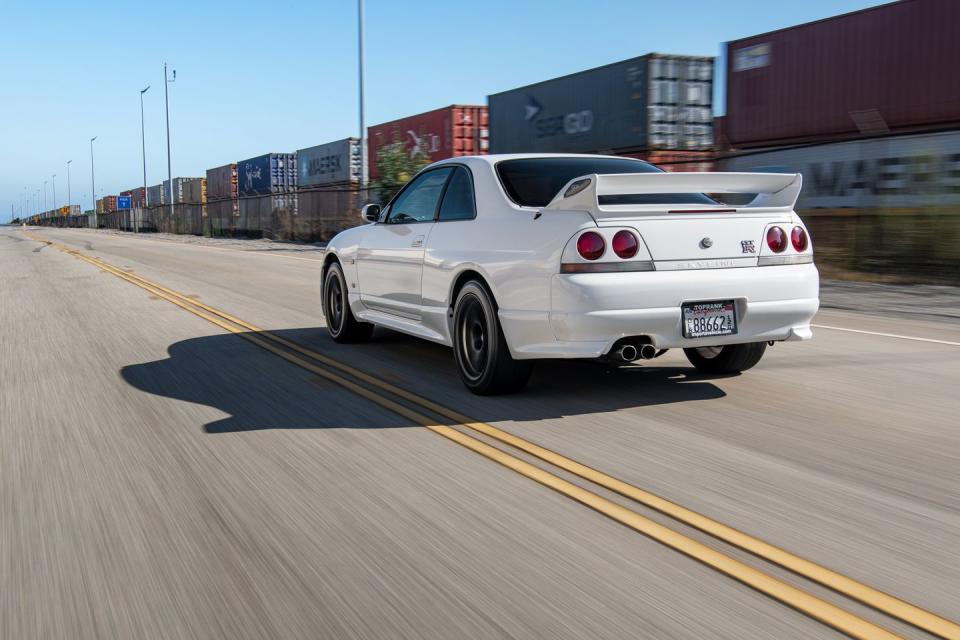
JDM Heaven
If Japanese domestic market (JDM) performance cars are your kink, Toprank's modest facility in Cypress, California, is your dungeon of pleasure. Its current inventory includes a rare Neutron White Pearl 1994 Honda NSX, a couple of FD-generation Mazda RX-7s, a Nissan Figaro, a 1991 Honda CRX SiR, a Suzuki Cappuccino, a handful of R32 and R33 GT-Rs, and an R34 once owned by the late Paul Walker. "This car was imported by MotoRex about 20 years ago," Morris said of Walker's car. "It's one of the few legal R34s in the country."
We've bummed rides from Morris before. Last year he supplied us with a 1992 Mazda Autozam AZ-1, a 1993 Nissan Skyline GTS-25, and a 1993 Toyota Mark II Tourer V for a story on JDM vehicles that were never sold over here but could now be imported legally. In the U.S., any car 25 years or older can be brought into the country with exemptions from a range of NHTSA regulations, including emissions. R32 GT-Rs have been legal since 2014. As of January 2021, the 1995 R33 GT-R makes the cut.

Morris says registering any of these right-hand-drive cars is a snap in 48 states. Hawaii has some safety regulations that can make things a bit more difficult, and California has its own set of rules. Before a resident of the Golden State can register any GT-R for the road, it will have to be modified to pass strict emissions testing. Toprank sends its cars to G&K Auto Conversion in Santa Ana, California, which is the only lab to have both California and direct-import certification. The process costs $10,000 and takes about two months, after which the car will still have to pass a smog test every two years like every other post-1975 model registered in the state.
Prices Are Climbing
Nissan built 16,668 R33-generation GT-Rs, which is about three times the number of R32s it produced between 1989 and 1994. Today both models cost about the same, averaging around $48,000, but prices continue to climb; a few years ago a great-condition R32 cost less than $30K. R34s, which will hit the magic 25-year mark in 2024, largely remain forbidden fruit. The few that have been imported and are street legal cost more than five times as much.
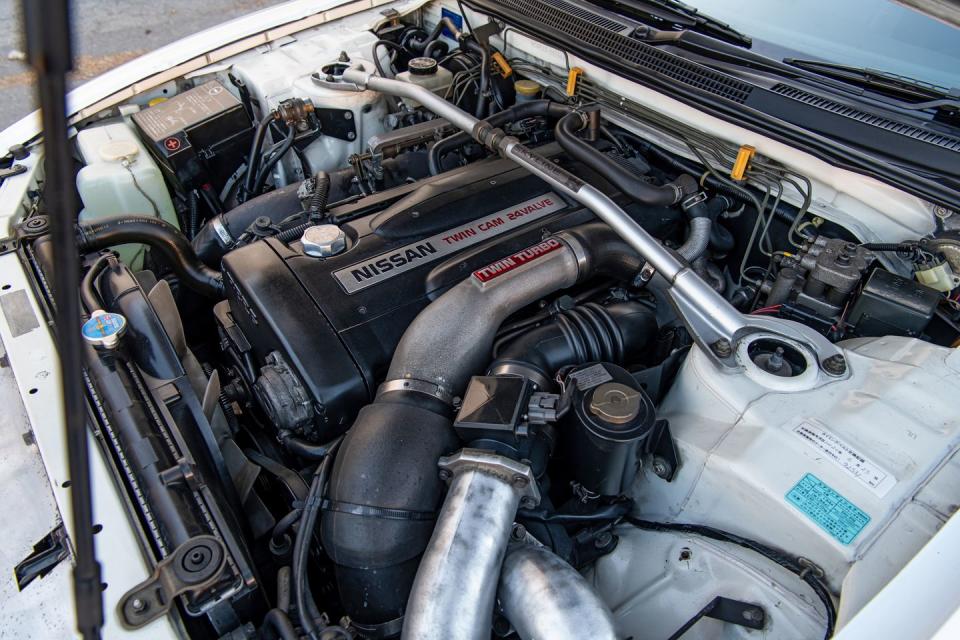
"They're all very similar mechanically," Morris said, "but they did get a little more power and a little stiffer structure over the years." They grew larger and heavier, too. R33s are five inches longer than R32s and have an additional four inches between their axles. At 184.1 inches long, an R33 is as big as the current R35 GT-R. All three early generations of GT-Rs feature an aluminum hood and fenders, but the R33 V-Spec we tested 25 years ago still weighed 3574 pounds, which is about 300 more than a typical R32. Still, by today's standards an R33 feels small, light, and airy, thanks in part to its thin A-pillars and large greenhouse.
R33 GT-Rs came in three flavors: GT-R, GT-R V-Spec, and the V-Spec N1, which is the hottest of the bunch. The N1 got a stiffer suspension, and the deletion of its ABS, air conditioning, audio system, and rear wiper made it lighter. Many of the cars Morris deals with have a few modifications. "This one is mostly stock," he said, lifting our R33's hood. "Inside, only the steering wheel, shift knob, and audio head unit have been changed. The only engine mods are open-element air filters, which are common. This car has the stock suspension and the stock exhaust, which is rare. The wheels have also been swapped, but they're the stock size."
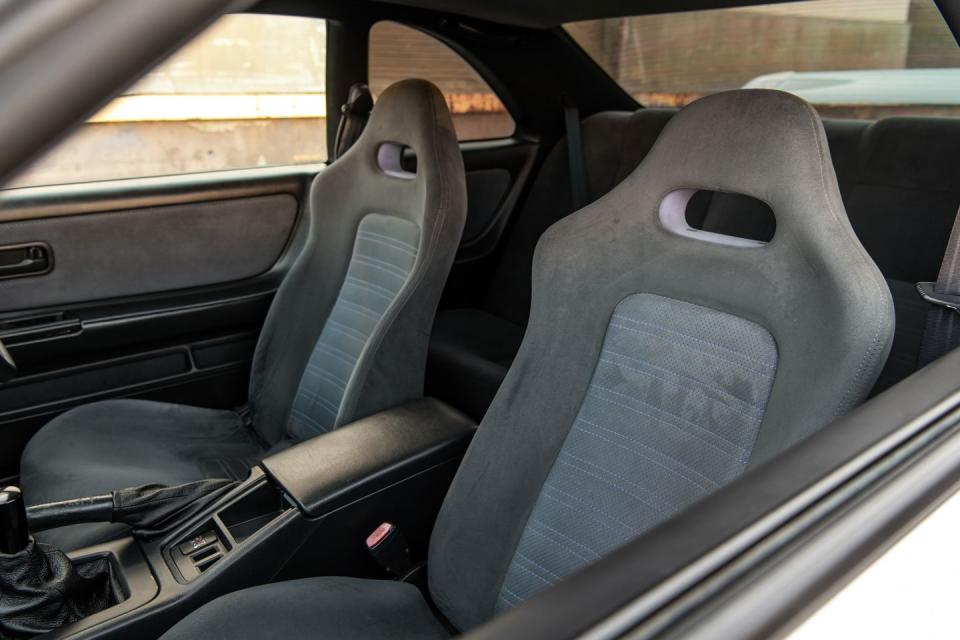
The R33's odometer reads 92,594 kilometers, or just 57,535 miles. Its interior backs up that number with very little wear on the seats and carpet. You sit upright in these cars, and the stock seats are well bolstered and covered in grippy cloth. Although this example is mostly stock, it does feature the N1 model's two rectangular front bumper scoops and small front spoiler on the leading edge of its hood. Both are common upgrades.
A Cult Classic
In 1995 we said the R33 GT-R was "technically peerless" with its all-wheel-drive system, electronic rear steering (upgraded from a hydraulic setup on the R32), and its celebrated twin-turbo RB26DETT engine, one of the greatest inline-sixes of all time. Fed by two parallel ceramic turbochargers, dual mass airflow sensors, and six throttle bodies, this 2.6-liter was officially rated at 276 horsepower—a voluntary power ceiling agreed to by all Japanese automakers at the time. The actual figure is more than 300 ponies, with 271 pound-feet of peak torque.
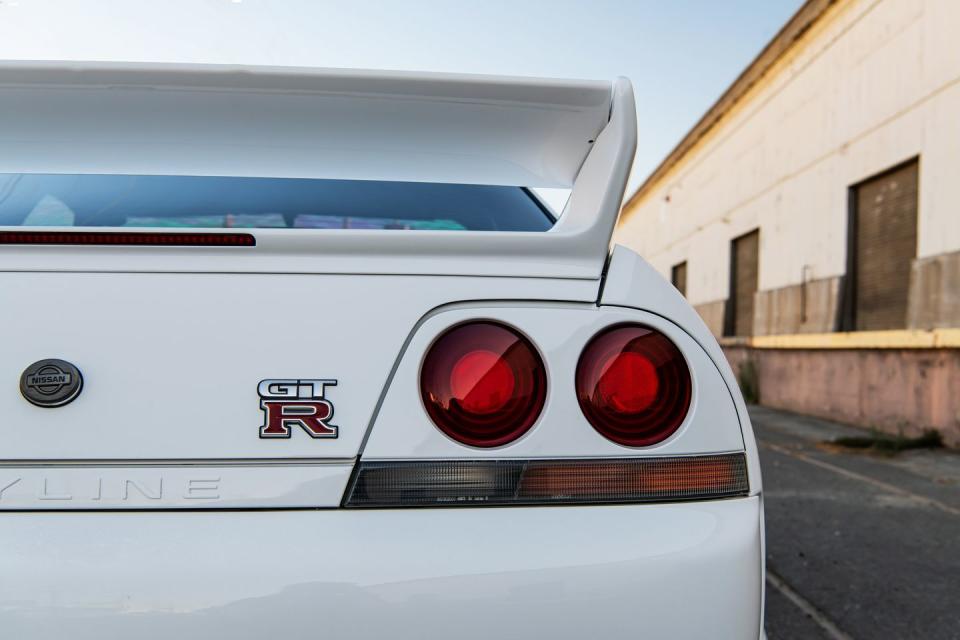
However, the six's 8000-rpm redline is very real, and the engine's refinement is right out of 2020. It idles smoothly, pulls from 1500 rpm, and revs hard above 5000, delivering a satisfying turbo woosh. Third and fourth gear keep the engine spinning comfortably and surprisingly quietly around town, with minimal exhaust roar and no obnoxious pops and bangs when you lift off the throttle.
The RB26DETT's turbos make 10.0 psi of boost in a stock R32, but they're cranked up to 12.0 psi in the R33 and 14.0 psi in the R34. These cars also feature a big front-mount intercooler, a limited-slip rear differential, 4.11:1 axle ratios, and R32s and R33s employed essentially the same five-speed manual transmission as the Nissan 300ZX. R34s got a six-speed. The R33's clutch pedal is rather heavy but easy to modulate. "The powertrain is stout," Morris said. "You can dump the clutch at 8000 rpm. It'll take it. But add big power, and the clutch is the weak point. Upgrades, including dual disc units, are popular."
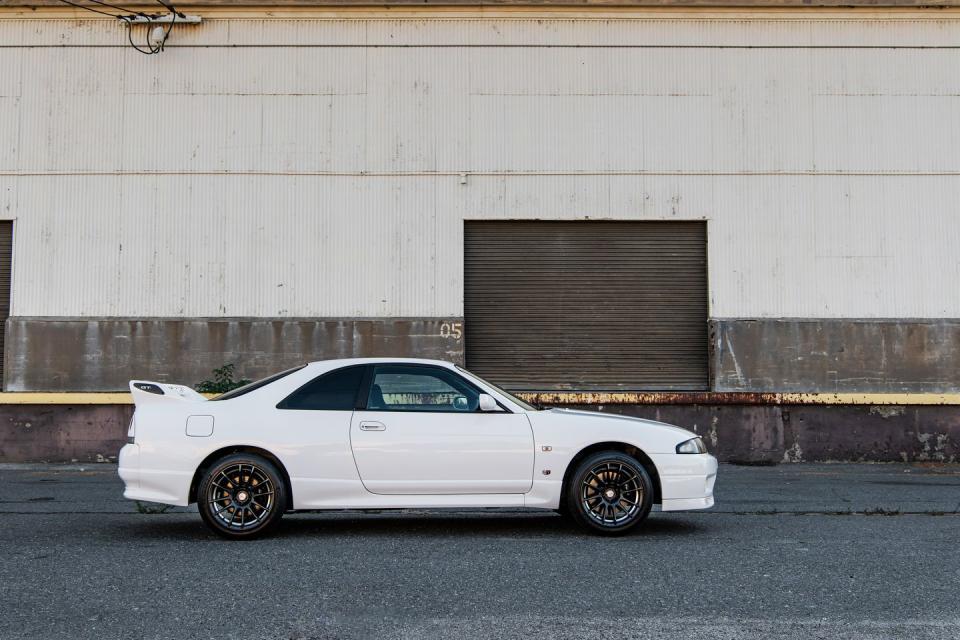
The R33 V-Spec we tested back in 1995 hit 60 mph in 5.3 seconds and covered the quarter-mile in 14.0 seconds at 104 mph. It also stopped from 70 mph in 159 feet and circled the skidpad with 0.94 g of grip. In today's terms, this GT-R performs like a Toyota Camry TRD. But it feels quicker than it is.
We were prepared for a punishing, tuner-car-like ride, but the R33's stock suspension—control arms front and rear with additional links in back—is agreeably firm. It corners flat, and there's more than enough grip to exploit. This particular R33 wears sticky Dunlop Direzza ZII summer tires, sized 245/45R-17, which undoubtedly provide more adhesion than the Bridgestone Expedias it came with from the factory. Beefy strut-tower braces front and rear surely help the chassis to also feel tighter and stiffer than we expected.
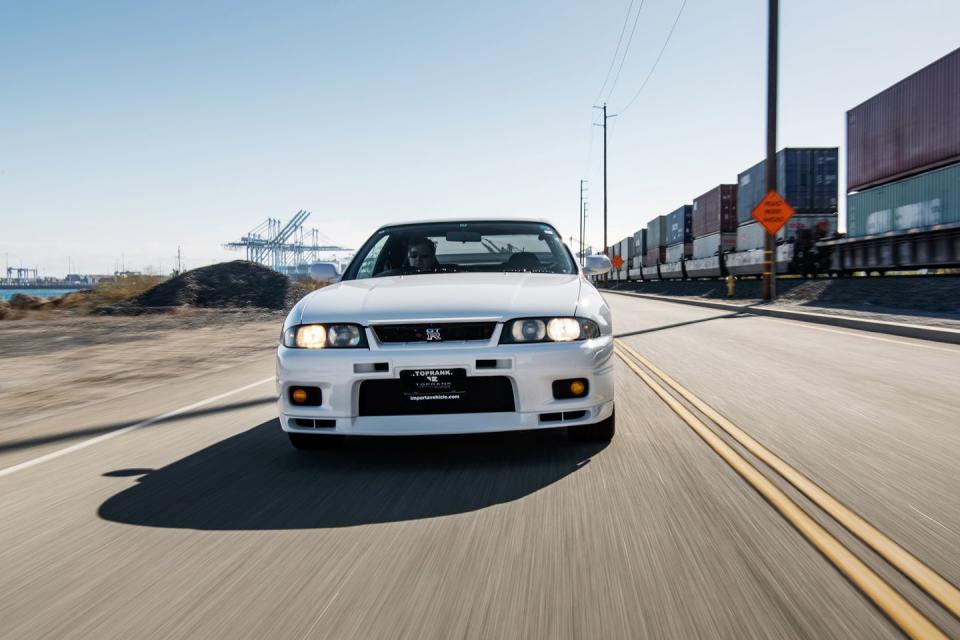
Driving the R33 reminds us of how visceral cars from this era are. Its steering is quick and communicative, and the rear diff binds a bit when you're making tight U-turns. It's all wonderfully mechanical without feeling crude. And its air conditioning blows ice cold.
Before returning the car to Morris, we went for one last freeway blast, pushing the GT-R through a tight second-gear uphill onramp and running it hard through the gears. Merging into light traffic at more than 100 mph, the Nissan's big rear spoiler quivers in the rearview mirror. A trucker hangs his phone perilously out of his window to capture the R33's curves painted in the warm glow of the setting August sun. For his benefit we downshift to fourth and nail the throttle as he records our flyby from the cab of his Kenworth. It may be a quarter-century old, but an R33 GT-R in the U.S. turns heads like few cars can.
You Might Also Like

 Yahoo Autos
Yahoo Autos 